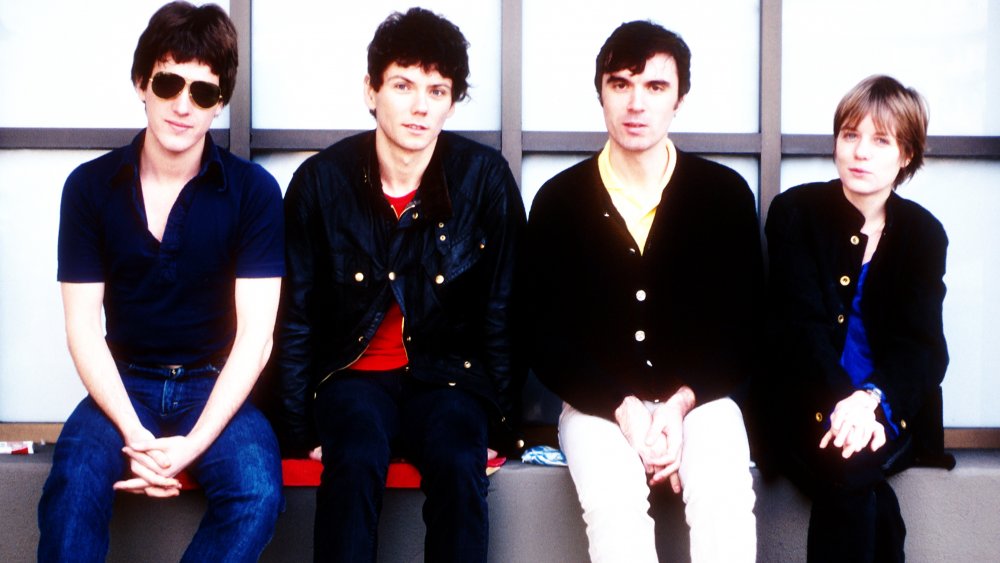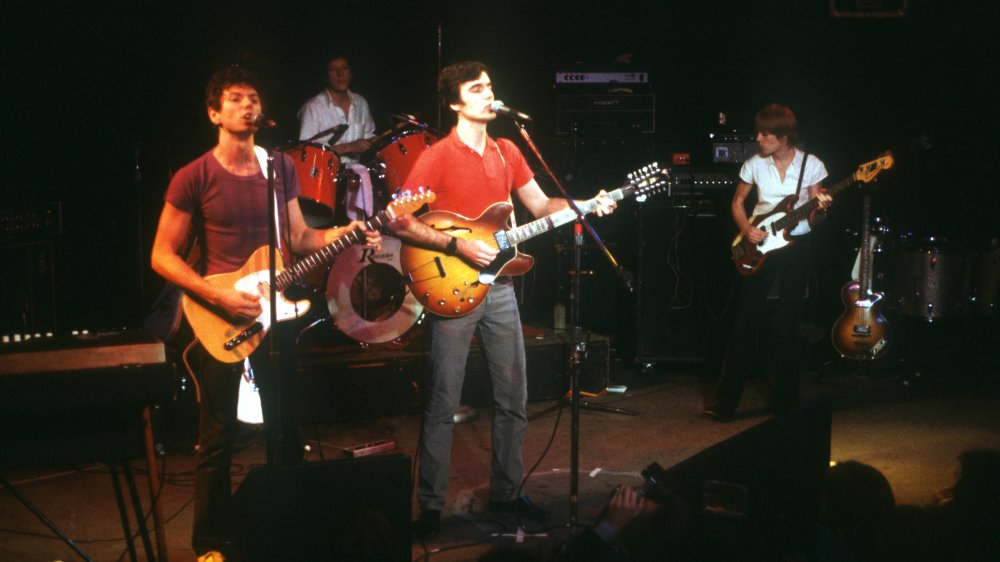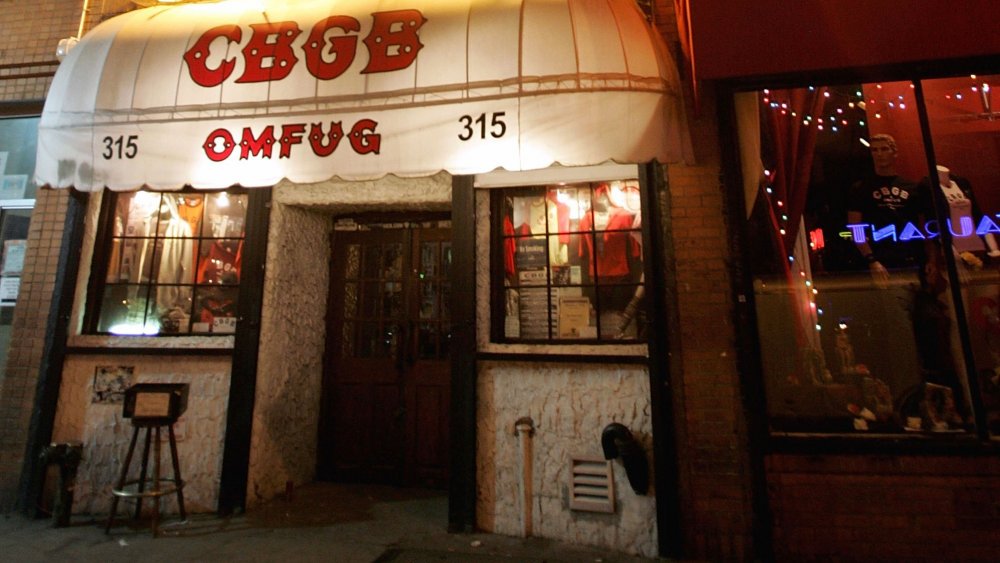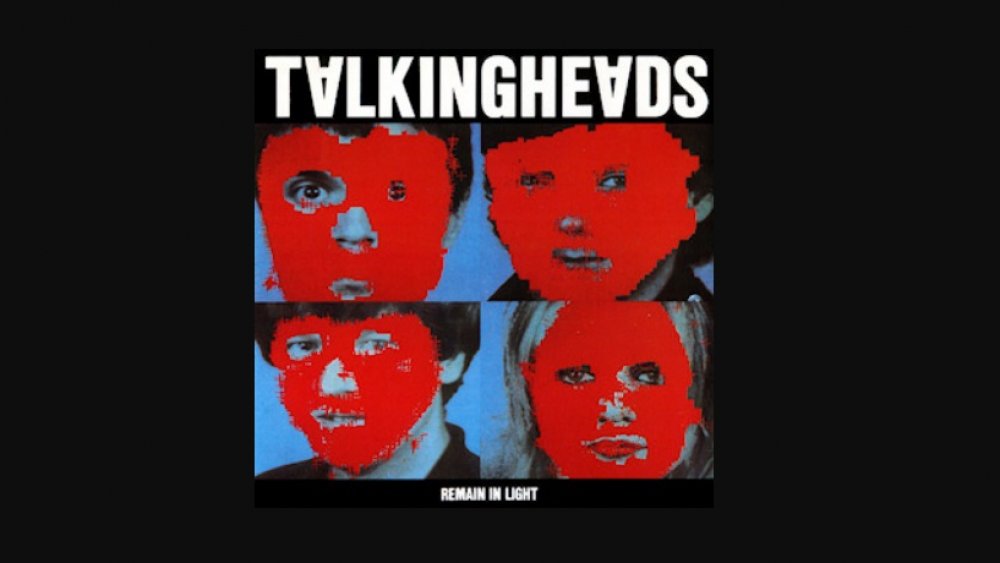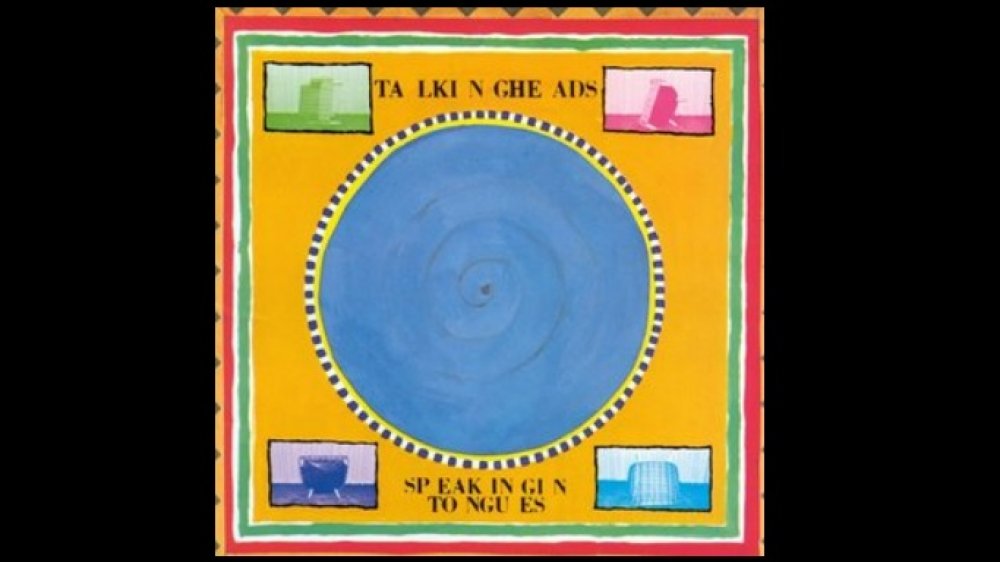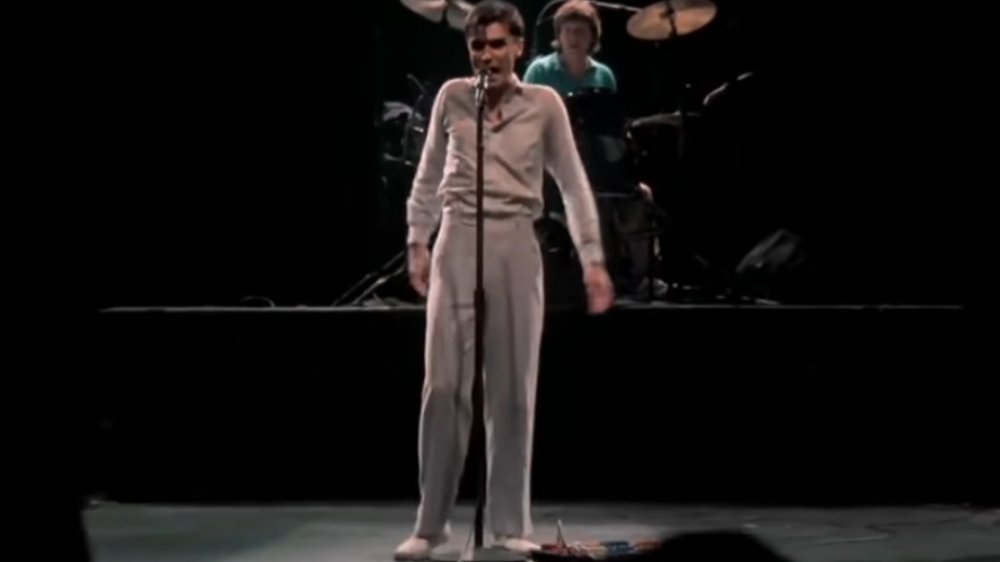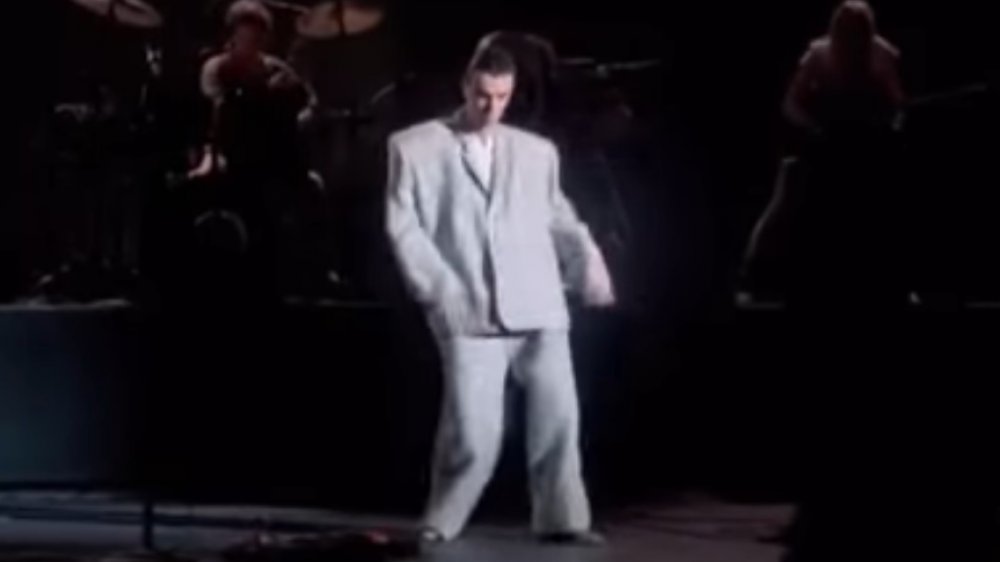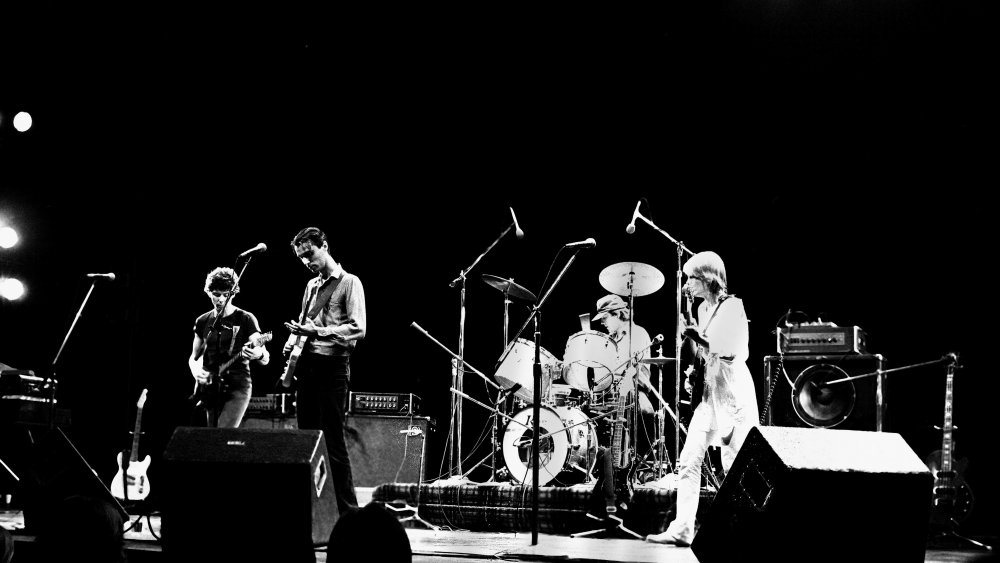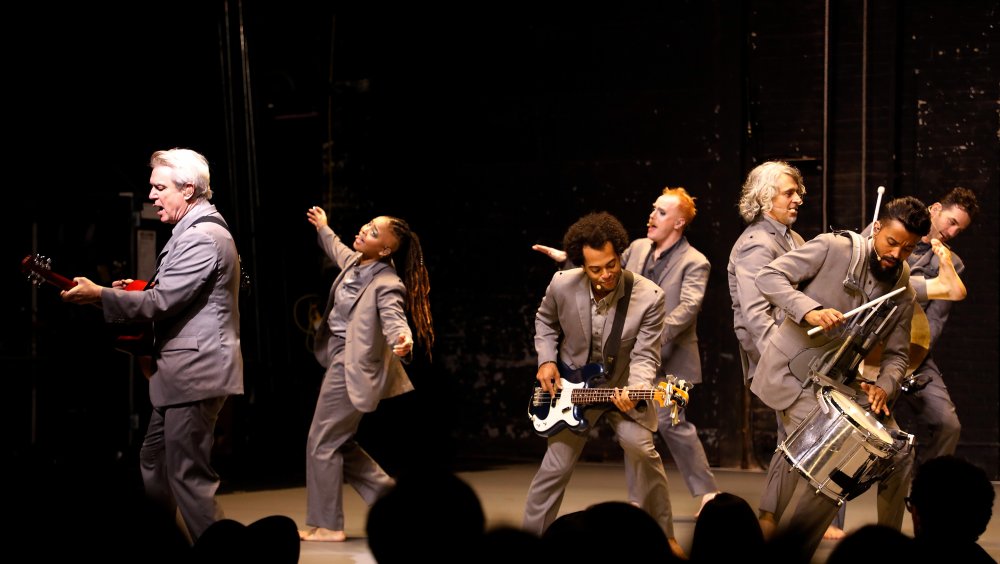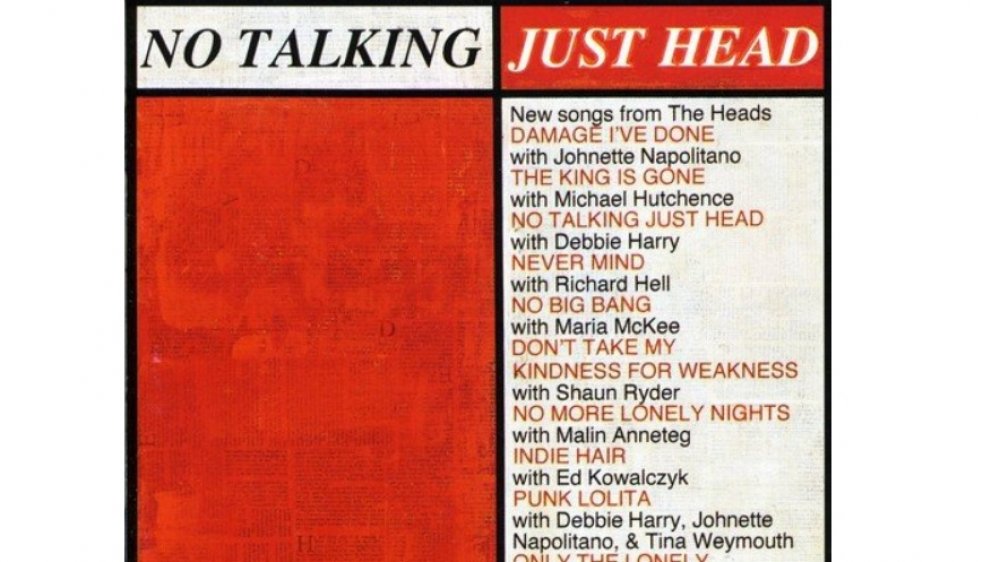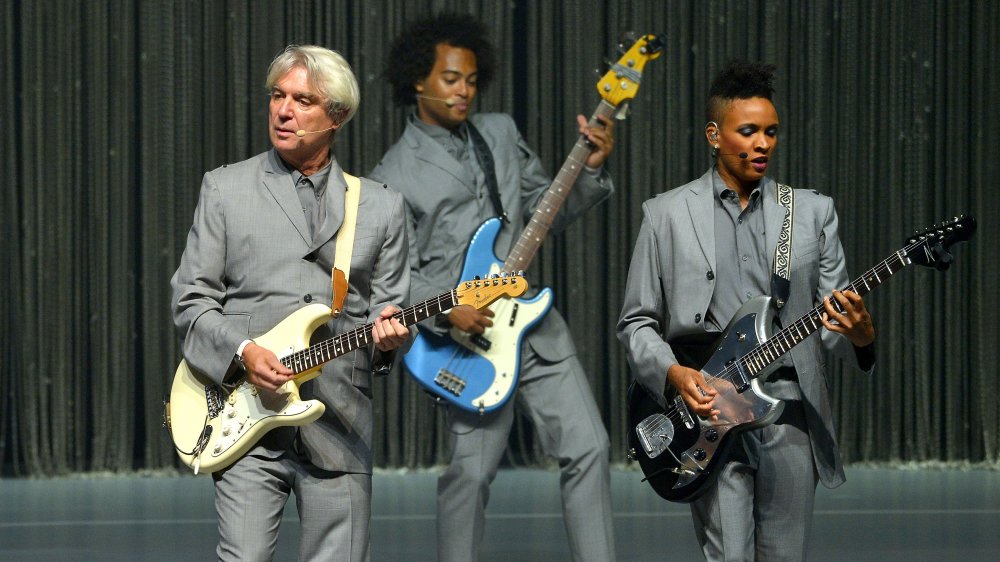The History Behind Talking Heads Explained
Talking Heads emerged from the punk rock scene of the late '70s, combing punk elements with big personality and an appetite for artistic exploration. The band would be called art rock by many, but they also crafted tunes that were catchy enough to hit the charts. Talking Heads would eventually help pioneer new wave music, which, per Lexicon Magazine, "is said to have borrowed its names from the French New Wave cinema that was shown in the 1950s." According to BBC, "The group helped to pioneer new wave music by integrating elements of punk, art rock, funk, and world music with avant-garde sensibilities and an anxious, clean-cut image."
Talking Heads would become critically successful and four of their albums would appear on Rolling Stone's list of The 500 Greatest Albums of All Time, as well as many other top rock lists, reports Kerrang! The band would last until 1991 and would eventually reunite to be inducted into the Rock and Roll Hall of Fame. Unfortunately, past feuds and issues have prevented the band from reconciling their differences — they haven't played together since that historic night. It's been an incredible ride for the "Once in a Lifetime" band. Here is the history behind Talking Heads explained.
From Artistics to Talking Heads
In the early 1970s, Chris Frantz, Tina Weymouth, and David Byrne would meet while students at Rhode Island School of Design (RISD). Byrne, who was known as "Mad Dave" on campus, would spend his time creating wild art exhibits. In fact, Byrne and Frantz had crossed paths as students but never knew each other until they were introduced by a friend who needed help on a soundtrack for a student film.
In an interview with Rolling Stone, Frantz spoke about their formal meeting, saying: "He said, 'I'm going to bring a guy along I know who plays guitar. Maybe you can do it together.' I said, 'Fine.' He brought in this guy, David Byrne, who I kind of knew already. I recognized him, but didn't really know him because David and I were in the same freshman class at RISD. He later dropped out, but we didn't have any classes together, so I didn't really know him then. During our freshman year, he had this big, long beard and wore grandfather-type clothes."
Frantz and Tina Weymouth would also meet while students at RISD, forming both a band and a relationship that would lead to marriage. After working on the student film, Byrne and Frantz would collaborate on songs and write "Psycho Killer" for their band The Artistics. Rhode Island School of Design Alumni Magazine wrote that Weymouth also took part in writing the famous song, but it would take two more years of convincing from Frantz before she would join the band. The trio's next step was moving to New York.
Talking Heads open for the Ramones at CBGB
By 1975, according to the NY Post, Byrne, Frantz, and Weymouth would practice every day on the 9th-floor loft of a building in New York City. Now Talking Heads, the band would spend their time at the famous rock club, CBGB, getting to know other artists and looking for a chance to perform. One of the club's bands who was making a name for themselves at the time was the Ramones. Hilly Kristal, owner of the famous punk rock club, CBGB, would eventually ask Johnny of the Ramones if Talking Heads could open for them. "Hilly asked Johnny if we could open for them, and Johnny said, 'Sure, they're gonna suck, so no problem,'" Frantz said.
Talking Heads would play many more shows at CBGB and other venues while developing their sound and musicianship. In 1976, the band would eventually add their last member, Jerry Harrison, who'd been studying at Harvard and playing with the Modern Lovers. According to Ian Gittin's book, Talking Heads: Once in a Lifetime: The Stories Behind Every Song, Weymouth, a fan of the Modern Lovers, had phoned Harrison and asked him to come to see them play in Boston. Harrison was impressed with their performance, and eventually, drove down to New York to jam all night with the band. After a few shows, Harrison was an official member and Talking Heads were soon on their way to being signed by Seymour Stein of Sire Records.
Talking Heads 77
The following year, the band released their debut album, Talking Heads 77. The band recorded at Sundragon studio in New York City and contended with electricity blackouts and turbulent recording sessions with Tony Bongiovi, cousin of Jon Bon Jovi, according to author Ian Gittins. The album didn't chart in the US and only went to #60 in the UK, per Rhino. The album's single, "Psycho Killer," which was written while the band members were in art school, came out during the time of the Son of Sam killings in New York City. The song would help the band gain exposure and become a classic.
Gittins said the album "demonstrated that here was a band who were both firmly of their time and utterly precedented. They adhered technically at least, to the principles of punk rock: there were no flatulent guitar solos or keyboard flourishes to tarnish this clipped, cryptic music. But neither, thankfully, was there even a hint of punk's routine, irate reduction of music to three or four thrashed chords."
Talking Heads started to improvise
By 1980, the band was working with Brian Eno, who contributed heavily to their songs. According to NPR, Talking Heads realized pop music was changing and started mixing up their sound. "The first time I ever met Talking Heads, I played them a record by Fela Kuti, the African-Nigerian musician who'd invented that thing called Afro-beat," Eno told NPR. "I thought that was just the most exciting music going on at the time."
Eno and Talking Heads approached songwriting differently by improvising in the studio, recreating the grooves of Kuti's music. They would record their jams, play them back, then look for sections of music that stuck out. They would use the bits of music they liked and repeat them, the same way hip hop producers sample music.
Talking Heads would end up writing one of their most well-known songs, "Once in a Lifetime," for their fourth album, Remain in Light. Byrne and Eno added different rhythmic layers over the famous bass line by Weymouth, the Guardian describes. Byrne's singing is inspired by "the call-and-response style rantings of American radio evangelists."
"We're largely unconscious," Byrne told NPR when speaking about the song. "You know, we operate half awake or on autopilot and end up, whatever, with a house and family and job and everything else, and we haven't really stopped to ask ourselves, 'How did I get here?'" The music video for the song was featured heavily on MTV right after its launch.
Talking Heads have their first and only top 10 hit
After a three-year hiatus, the band returned to the studio to put out Speaking in Tongues in 1983, their follow-up album to Remain in Light. In between albums, the band members would work on solo projects which would influence the writing for their new release. Rolling Stone discovered the influence of "David Byrne's propulsive score for Twyla Tharp's 1981 dance piece The Catherine Wheel," on Speaking in Tongues. They also heard polyrhythmic keyboard layers from Jerry Harrison's solo LP, The Red and the Black, as an influence.
While Brian Eno wouldn't work with the band on this album, they'd still take huge risks creatively and write songs that evolved the band's sound. The album earned them their only top 10 single with the hit "Burning Down the House." Ultimate Classic Rock said the song "set the tone for the record — both in terms of its sound, which took the angular art-school vibe of the band's early releases and infused it with heavy R&B and soul overtones, as well as its writing style, which found Byrne vamping gibberish over rehearsal demos until the lyrics revealed themselves and giving the album its title."
"Stop Making Sense" showcased the band on tour
Talking Heads teamed up with The Silence of the Lambs director Jonathan Demme to make the influential and classic concert film, Stop Making Sense. Demme joined Talking Heads for three nights in December 1983 at Los Angeles' Pantages Theater to film the movie which was released the following year. As NME reported, the film explored the band's weird, intimate side while performing live and captured David Byrne's "daring approach to theatrics." Demme used many techniques to give audiences intimate perspectives which brought viewers closer to the band.
According to Esquire, Demme didn't try to create an idea of the band, he let their personalities come through naturally and allowed them to relax on stage with as little direction as possible. "In Stop Making Sense, he immortalized Talking Heads as the epitome of energetic, joyful absurdity and, without ever forcing it upon them, made viewers take pride in what makes them weird themselves."
Everything has to be bigger for Talking Heads
David Byrne's famous big-shouldered grey suit has a story of its own. The suit is a staple of the performance from their concert film, Stop Making Sense, and has been parodied and celebrated many years since. Byrne eventually talked about how the suit was inspired and why he identified with its design. In a filmed interview, Byrne said: "I like symmetry; geometric shapes. I wanted my head to appear smaller and the easiest way to do that was to make my body bigger. Because music is very physical, and often the body understands it before the head."
According to Put This On, in an interview with Entertainment Weekly, Byrne said: "...a friend made a kind of quip, while I was trying to think of what to do on this next tour, what to wear, and he said: 'Well, you know what theater is — everything has to be bigger.' And he didn't mean the clothes had to be bigger, he meant that the gestures were larger, the music had to be more exaggerated, on stage than they would in real life. But I took it very literally." Apparently, David Byrne had recently been to Japan and taken in a lot of Japanese theater and modeled his front-facing outline business suit after the shape of the costumes worn there. He and designer Gail Blacker collaborated on the architectural garment, choosing a grey tone to fit stage lighting.
Talking Heads broke up unexpectedly
In 1991, Talking Heads broke up after David Byrne was interviewed by the Los Angeles Times' Sunday Calendar Pop Eye column, saying: "You could say (we've) broken up, or call it whatever you like." The other members knew Byrne had become more distant from the band over the years as he engaged in solo projects. Meanwhile, Tina Weymouth, Chris Frantz, and Jerry Harrison worked on solo projects but they kept their allegiance to the main band they loved. Byrne's announcement of the band's breakup came as a huge shock to the other members, who figured they were just on hiatus. Frantz said, "As far as we're concerned, the band never really broke up. David just decided to leave."
In an interview with Courant, Weymouth recalled that a manager told her and Frantz that Byrne wanted to strike out on his own for the money. "Apparently he'd been trying for years to cut the band out of the picture," Weymouth said, still obviously hurt. "It shocked us because for years every time we wanted to take the band out on tour, he'd say, 'All you want is the money!' The last time we met, he yelled at us about being greedy for money. We made two albums because he wanted all the writing credits. He said, 'I won't make these albums unless you give that to me.' So we did."
Talking Heads continue solo projects
Before Talking Heads broke up, the members had started to pursue solo projects. Chris Frantz and Tina Weymouth started working on Tom Tom Club in 1980 as a way to fill time between Talking Heads projects. Their song "Genius of Love" became a hit and classic, per the Los Angeles Times. They also worked as a record production team and oversaw albums for Ziggy Marley & the Melody Makers and Happy Mondays. Jerry Harrison put out solo albums, became a record producer, and worked on albums with bands such as Crash Test Dummies and Live. According to Rolling Stone, Harrison also co-founded a company that creates antidotes for snakebites.
David Byrne worked on many different albums and projects such as film scores, collaborations with artists like Fatboy Slim, and a Broadway production of his solo album American Utopia. Byrne would work on the soundtrack for Bernardo Bertolucci's The Last Emperor in 1987 and win a Golden Globe and Academy Award. According to GQ, Byrne also wrote a book, How Music Works, in which he talked about everything from diagnosing his younger self with Asperger's syndrome to how money is made in the recording industry.
Talking Heads ... but without David Byrne
According to MTV, in 1996, the remaining members of Talking Heads planned to release an album called No Talking, Just Head, and perform under the name The Heads. They wanted to reunite as a band and continue the legacy of Talking Heads but according to Frantz, Byrne wasn't interested. According to Diffuser, Frantz said: "We tried everything in our power to have David reconsider and join us, but after a certain point, we just gave up," Frantz told the Orlando Sentinel (per Diffuser) in 1996. "He's doing his thing and we're doing ours."
Byrne ended up filing a lawsuit against Weymouth, Frantz, and Harrison, to try and stop them from using the name. Eventually, Byrne dropped the lawsuit. In the MTV article, Byrne's attorney was quoted, saying: "Byrne agreed to let the name be used in exchange for some concessions on the part of the others regarding previously disputed Talking Heads business."
Diffuser writes that Heads would collaborate with other lyricists and singers, including Debbie Harry of Blondie, Andy Partridge of XTC, Michael Hutchence of INXS, Gordon Gano of Violent Femmes, Ed Kowalczyk of Live, Richard Hell, Shaun Ryder of Happy Mondays, and Johnette Napolitano of Concrete Blonde.
Talking Heads reunited one last time for the Rock and Roll Hall of Fame
In 2002, Talking Heads would finally reunite all the original members of the band for their induction to the Rock and Roll Hall of Fame. Talking Heads were getting inducted and the members of the band would put aside all their quarrels from the past. According to Rolling Stone, in preparation for the awards, Talking Heads spent a couple of days rehearsing "Psycho Killer," "Life During Wartime," and "Burning Down the House." They began rehearsing as a four-piece, then added percussionist Steve Scales and keyboardist Bernie Worrell to the lineup.
The band was inducted by Anthony Keidis of Red Hot Chili Peppers the same night as their old set-mates, the Ramones. It was a night many fans had been waiting for, and unfortunately, it's still the only night the band has played together since. The performance showed a rough version of the band's abilities, causing some to wonder if there was tension before the show. "With the exception of Tina, we all could have been a little bit looser," Frantz later said. "But gimme a break — we hadn't played together for something like 18 years. So I think we did good."
David Byrne hit Broadway with American Utopia
One of David Byrne's most recent and celebrated projects is American Utopia, his concert-theater-dance installation that premiered on Broadway in 2019. Rolling Stone reports that it combines "20 songs from both Talking Heads and his solo albums along with bits of storytelling and humble advice, it's Byrne's secular church offering a tonic for our tumultuous times — six times a week." The show features performers dressed in grey suits and barefoot dancing and singing with Byrne. Everyone has the ability to dance around and move, so there are no instruments or placed equipment on the stage; rather, all members carry their instruments or have them strapped to their bodies. "We're untethered," Byrne explained later. "That's what this show is about."
The audience is invited to eventually fill the aisles and dance near the stage at a certain point in the show. "When Bryne finally did give the crowd permission to get into the groove — before "Burning Down the House," near the end of the show — it seemed to unleash a collective pent up need," Rolling Stone reported. The show brings fans together with their hero and allows them to celebrate all the work they adore, Talking Heads and all, without the nonsense of feuds and gripes between band members which got in the way of what they gave the fans and themselves: the music.
